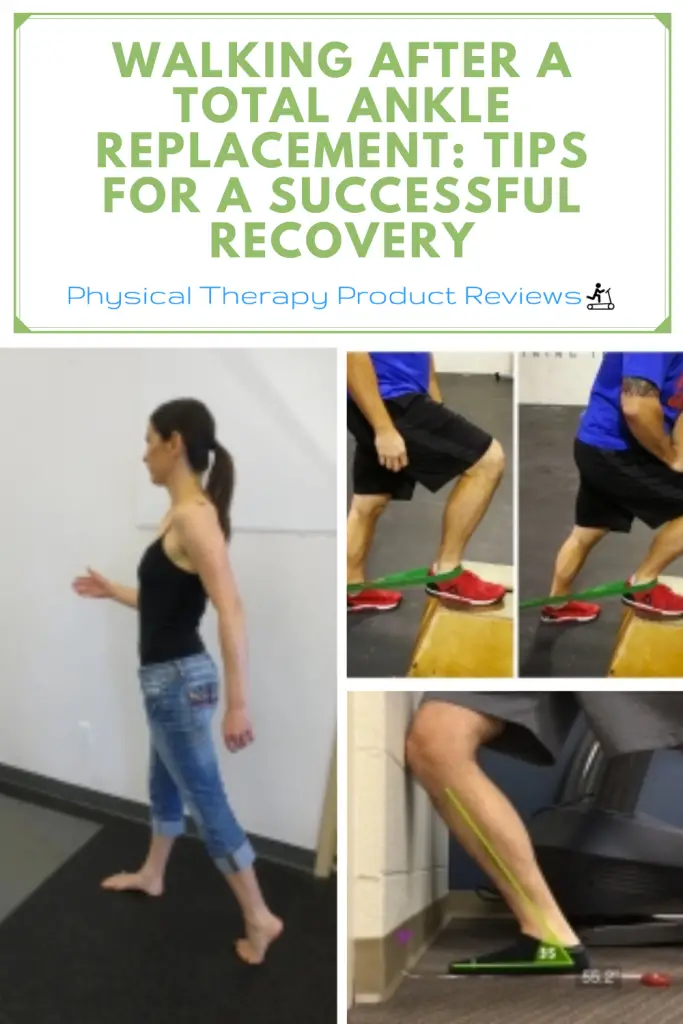After undergoing a total ankle replacement surgery, patients need to follow a strict rehabilitation program to regain mobility and improve their overall gait pattern. Physical therapy is an essential part of the recovery process, and it helps patients to achieve their goals and get back to their daily activities.

During the initial phase of recovery, patients are restricted to staying non-weight, bearing on the affected ankle for several weeks. Once the surgeon clears them to begin walking on their leg again, physical therapy sessions can begin. The therapist will work with the patient to improve their gait pattern and eliminate any limping.
After total ankle replacement surgery, physical therapy may include exercises such as gait training, massage to decrease swelling, strengthening exercises, stretches for range of motion and flexibility, and weight-bearing activities that get harder over time. The goal is to help patients regain their mobility and independence, reduce pain and swelling, and prevent future ankle injuries.
In this blog post, we’ll cover some of the common questions after total ankle replacement and share our favorite exercises to start walking normally again.
Table of Contents
Post-Surgery Precautions
Weight-Bearing Restrictions
After a total ankle replacement surgery, patients must follow weight-bearing restrictions to ensure proper healing of the ankle joint. The surgeon will provide specific instructions on how much weight can be put on the affected ankle and for how long. This is surgeon dependent but, on average, is between 4-6 weeks of non-weight bearing.
Typically, patients are required to stay non-weight bearing for several weeks after surgery, using crutches or a walker to move around. When you are using crutches for that long, make sure that you have the most comfortable set of crutches, it can make a big difference. If you have difficulty using crutches for that long, then we recommend using a knee scooter to get around and make it easier to go to work. Gradually, weight-bearing is increased, and physical therapy is initiated to help improve strength and stability in the ankle joint.
Physical Therapy
Physical therapy is essential to the recovery process after a total ankle replacement. Physical therapy aims to improve the range of motion, strength, flexibility, and balance. Physical therapists will work with patients to develop an exercise program tailored to their specific needs and abilities. These exercises may include:
- Range of motion exercises to improve ankle flexibility
- Strengthening exercises for the ankle joint, calf muscles, and thigh muscles
- Balance and coordination exercises to improve stability and prevent falls
Physical therapists will also provide guidance on how to properly use assistive devices, such as crutches or a walker, to ensure safe and effective movement during the recovery process.
Recovery Timeline After An Ankle Replacement
First 2 Weeks
During the first two weeks after total ankle replacement surgery, the patient will be required to keep their leg elevated and not place weight on their foot. This is to allow the ankle to heal properly and reduce swelling. The patient will likely be given pain medication to manage any discomfort. Physical therapy may begin during this time to help improve blood flow and range of motion.
2-6 Weeks
After the first two weeks, the patient will begin walking in a boot and continuing physical therapy. The boot will support and protect the ankle as the patient begins to put weight on their foot. It is important to follow the physical therapist’s instructions and not push too hard too soon. The patient may also be given exercises to do at home to help improve strength and flexibility in the ankle.
6-12 Weeks
At this point, most patients are able to wear normal shoes and begin limited activity. The patient will continue physical therapy to improve balance, coordination, and strength. The physical therapist may also work with the patient to improve their gait and eliminate limping. It is important to continue following the physical therapist’s instructions and not push too hard too soon.
3-6 Months
During this time, the patient will gradually increase their activity level and may begin more strenuous exercises. The physical therapist will continue to monitor the patient’s progress and adjust their therapy as needed. It is important to continue doing exercises at home to maintain strength and flexibility in the ankle.
6-12 Months
By this point, the patient should have regained most of their strength and mobility in the ankle. However, it is important to continue doing exercises and following the physical therapist’s instructions to prevent future injury and maintain overall health. The patient may also need to schedule follow-up appointments with their surgeon to monitor the ankle’s progress.
Returning to Walking After a Total Ankle Replacement
Exercises to Improve Walking Mechanics
After a total ankle replacement, working with a physical therapist to improve walking mechanics is important. Exercises focusing on improving balance, strength, and flexibility can help restore normal walking patterns. Some of the exercises that may be recommended include stretches, ankle range of motion exercises, and balance exercises. There are also many drills that you can practice to try and normalize the ankle during an actual step.

Want the exact exercises that we prescribe in the clinic?
Download our ankle replacement walking guide, saving a trip to the therapist and saving you money on your medical visit.
Gradual Progression
Returning to walking after a total ankle replacement is a gradual process. Initially, the patient may need to use a walker or crutches to help support their weight and maintain balance. As the patient progresses, they may be able to transition to a cane or walking without any aids. The pace of progression will depend on the individual and their specific needs.
Despite successful surgery, ankles tend to remain stiff for a long time after surgery. That stiffness will gradually improve as muscle tightness and swelling slowly decrease, but this takes time. It’s important to remember this and not get frustrated if it takes time for your gait to normalize.
It’s not uncommon to feel less than normal, even 3 months or longer after surgery.
Choosing the Right Footwear After an Ankle Replacement
Choosing the right footwear is an important part of returning to walking after a total ankle replacement. Shoes should be supportive and provide good cushioning to help absorb shock. Choosing shoes that fit well and do not cause discomfort or rubbing is also important.
The optimal shoe will be supportive in the ankle but also be a bit more flexible at the same time to accommodate the changes in swelling after swelling. You’ll also want something lightweight instead of a heavy hiking boot to make it easier on your ankle to walk.
Some of our favorites include the Altra or the Hoka hiking-style shoes. These are more lightweight than regular hikers but have higher-style tops to support the ankle. At the same time, they also have an arch support to stabilize motion laterally.
Walking Aids
Walking aids such as canes, walkers, knee scooters, and crutches are important during the early stages of returning to walking after a total ankle replacement. These aids provide support and help to maintain balance while walking. During the early phase, patients must wear a walking boot and then can slowly transition to normal shoes. While in the walking boot, people can learn to walk normally again using a walking aid.
Nearly everyone starts with a front-wheeled walker until they can normalize their gait. Once the amount and severity of limping start to reduce, people transition to a single-point cane. The cane helps with small weight acceptance and, most importantly, helps with balance.
For those that require mobility over a large distance, you might need to use a knee scooter. These take pressure off the ankle and help people navigate the workplace. As far as crutches go, most people rarely use them. People require the support of the walker and then progress quickly enough that crutches are rarely needed and “skipped.” Returning to walking after a total ankle replacement is a gradual process requiring patience and dedication. By working with a physical therapist and following a structured rehabilitation program, patients can improve their walking mechanics and return to normal activities.
Conclusion
Walking after a total ankle replacement can be a lengthy process, but with proper rehabilitation, patients can regain their mobility and return to their daily activities. The length of time before a patient can walk after surgery varies, but typically patients are non-weight bearing for several weeks before gradually transitioning to weight-bearing activities with the help of a physical therapist.
Physical therapy is essential to the recovery process after a total ankle replacement. Patients work with their physical therapist to improve their overall gait pattern and eliminate any limping. The rehabilitation plan also incorporates exercises to improve strength, flexibility, and range of motion.
It is important for patients to follow their rehabilitation plan closely and communicate any concerns or pain with their healthcare team. While ankle replacement surgery can improve mobility and quality of life, it is not a guaranteed solution for everyone. Patients should have realistic expectations and understand the potential risks and benefits of the procedure.
Overall, walking after a total ankle replacement requires patience and dedication to the rehabilitation process. With proper care and attention, patients can regain their mobility and confidently return to their daily activities.
Disclaimer: The information provided in this post is for educational purposes only. This is not a substitute for a medical appointment. Please refer to your physician before starting any exercise program.


